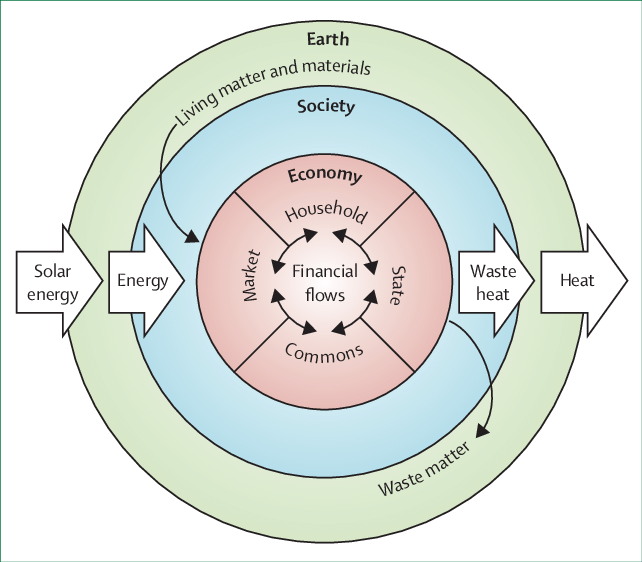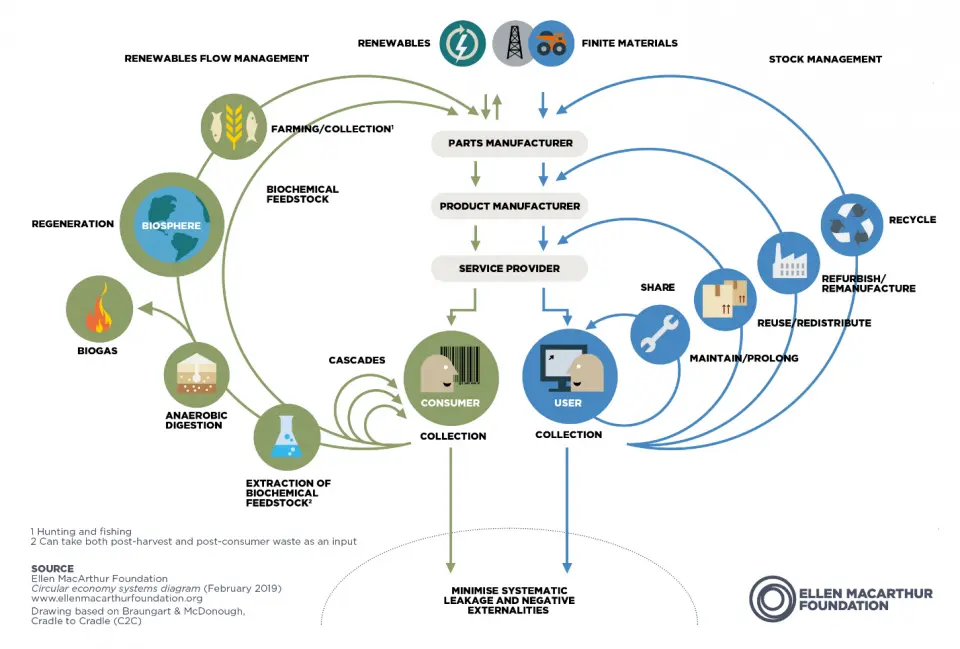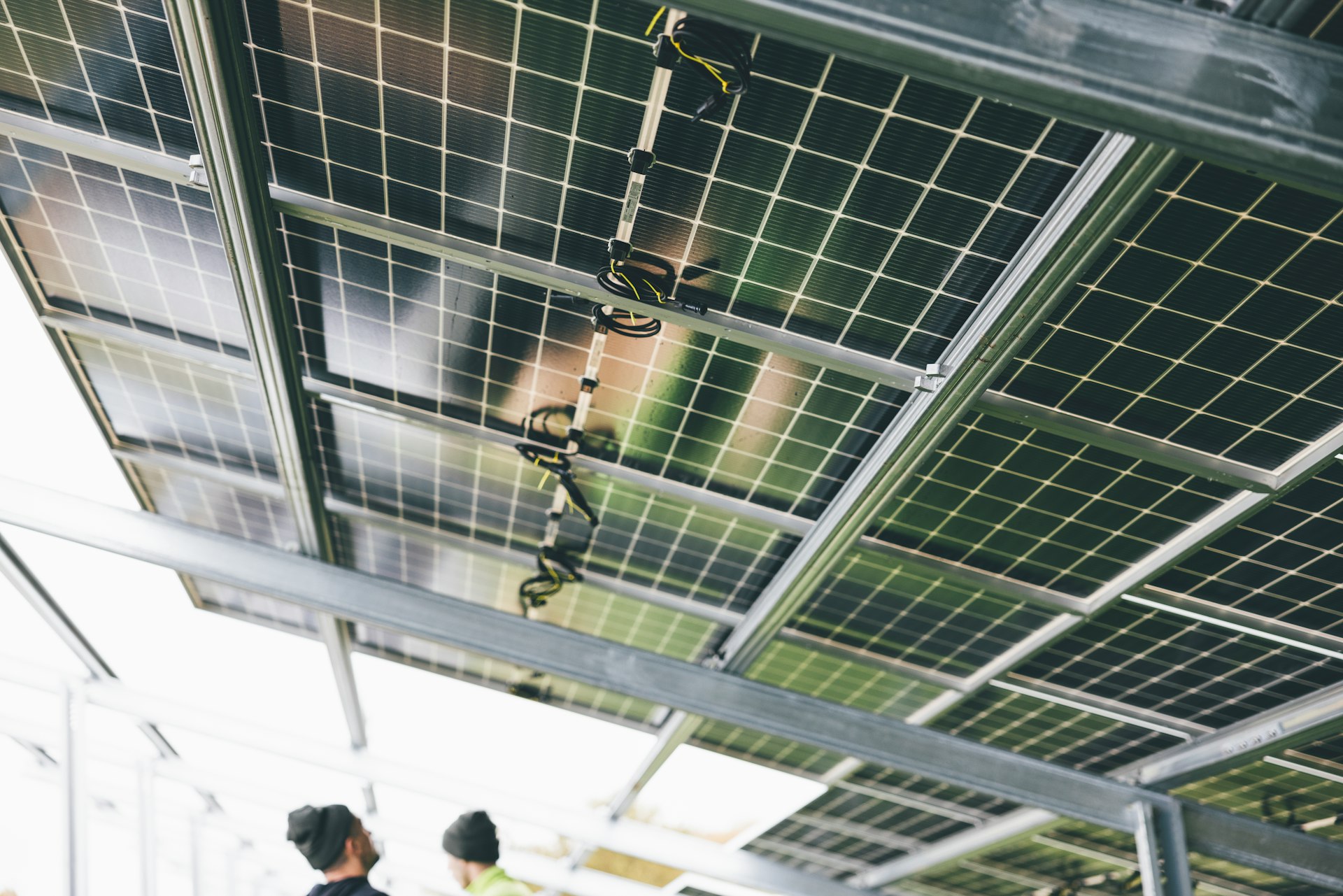The Dilemma of Infinite Growth in a Finite World
Imagine a magical gold coin that doubles every 25 years. Sounds harmless, right?
But in 4,600 years, those coins would weigh more than the observable universe!
This is exponential growth, and something similar is happening right under our noses: the global economy.

Why is growth so important?
Economists love growth.
They say we need it to improve our lives. Without growth, they think, we'd be fighting over crumbs instead of making more pies.
But wait a second... can we really grow forever on a planet that doesn't grow?
How do we measure this crazy growth?
Simple: we add up the value of everything we produce and sell.
From smartphones to sandwiches, everything counts!
But here's the catch: making things requires resources.
Your smartphone, for example, is made from materials extracted from the Earth and shaped by human sweat (and some cool machines).
The magic recipe:
Efficiency + Technology
Over the last 200 years, we've gotten incredibly good at doing more with less. It's like we're squeezing more juice from an orange every year.
How? With technology!
But beware: sometimes, our brilliant inventions make us want even more stuff. Oops!

The elephant in the room: Our planet is suffocating
Here's the scary part: our growth-hungry economy is devouring the planet.
Forests, oceans, the very air we breathe - everything is suffering. It's like we're at an amazing party, but someone's eating the furniture!
Two visions for the future:
The Techno-Optimists
"Don't worry! We'll invent our way out of this problem!"
The Economic Revolutionaries
"What if we stopped growing and focused on what really matters?"
A new kind of economy?
Imagine a world where we don't need constant growth. Where we focus on clean energy, health for all, and incredible public transportation. Where working less doesn't mean living worse.
Sounds utopian? Maybe. But flying or having pocket computers once sounded utopian too!
The Embedded Economy Model

The embedded economy model offers a fresh take on economics by showing how our economic activities are closely linked to social, cultural, and environmental aspects.
It reminds us that the economy is part of a bigger picture, connected to the world around us.
Key Aspects of the Embedded Economy Model
Social Provisioning
At its heart, the embedded economy model sees the economy as a way to support society by meeting our collective needs, rather than just a system focused on individual gains and economic growth.
Heterodox Economic Approaches
The embedded economy model draws insights from various heterodox schools of economic thought, including:
- Ecological Economics: This approach integrates economic thinking with ecological realities, often advocating for post-growth or degrowth strategies.
- Feminist Economics: This perspective brings attention to gender-related economic issues and unpaid labor.
- Modern Monetary Theory: This theory offers alternative views on monetary and fiscal policies.
Wellbeing Focus
The embedded economy framework closely mirrors the idea of a "wellbeing economy," which emphasizes the importance of human and environmental health over conventional economic indicators such as GDP growth.
Implications for Policy and Practice
Health-in-All-Policies (HiAP): The embedded economy model supports approaches like HiAP, which aim to incorporate health considerations into all areas of public policy.
Institutional Structures: The model highlights the role of institutional frameworks in economic outcomes. In South Korea, the developmental state legacy is evident in public institutions like the National Pension Service, affecting their responses during financial crises.
Historical Context: The concept of an embedded economy has roots in earlier economic thought. Karl Polanyi's work on "Socialist Accounting" explored ideas related to embedding economic activities within broader social structures[1].
How did South Korea's National Pension Service manage financial crises

During normal times, the NPS operates like a well-calibrated mechanism, its developmental state characteristics subtly integrated into its institutional framework. But when economic turbulence emerges, something remarkable happens. The institution's latent potential surfaces, adapting and responding with exceptional precision.
The Crisis-Fighting Toolkit
Institutional Flexibility
Like a strategic planner, the NPS can instantly recalibrate its policies and investment approaches. When economic conditions shift, it doesn't just react – it anticipates.
Strategic Investment Approach
During crises, the NPS doesn't just protect its interests – it actively supports the entire domestic economic ecosystem.
Government Coordination Mechanism
The NPS works in close alignment with other government institutions, creating a comprehensive economic response strategy.
What distinguishes the NPS is its ability to balance two critical roles: a social security guardian and an economic stabilization mechanism. It's not just managing a pension fund; it's helping an entire nation navigate complex financial landscapes.
Disclaimer: Economic complexities have been synthesized for clarity. Real-world financial dynamics remain inherently multifaceted.
Navigating Economic Turbulence: Challenges of South Korea's National Pension Service

Market Volatility Labyrinth:
Dynamic Investment Recalibration:
Crisis periods demand exceptional adaptability. The NPS must rapidly reframe its investment strategies, transforming potential losses into calculated opportunities. This requires not just financial expertise, but an almost intuitive understanding of emerging economic patterns.
Liquidity Tightrope Walking:
Balancing immediate pension obligations with long-term investment strategies becomes a critical challenge. The NPS must ensure sufficient financial resources are available to support beneficiaries while maintaining strategic investment positions.
Complex Policy Synchronization:
The pension service operates within a broader economic ecosystem. During crises, it must meticulously align its strategies with government economic policies, acting as both an independent financial entity and a collaborative economic stabilization mechanism.
Public Trust Preservation:
Beyond financial metrics, the NPS must maintain public confidence. During economic uncertainties, beneficiaries look to the pension service as a symbol of financial security and institutional reliability.
What's the obstacles and what can we do to move forward to this type of economy?
Imagine an economic model so revolutionary that it could rewrite our relationship with resources, waste, and sustainability.

This Ellen MacArthur Foundation system diagram illustrates the continuous flow of technical and biological materials through a circular economy.
The transition to a circular economy faces several obstacles, but there are also strategies to overcome these challenges and move forward. Understanding these barriers is crucial for developing effective solutions and implementing a circular economy model.
The Obstacle Ecosystem For Implementation
Sociocultural Inertia:
Picture an intricate web of deeply ingrained habits and mindsets. Changing societal perspectives on consumption and waste is like steering a massive ship – slow, requiring immense energy and collective effort.
Legislative Frameworks:
Current regulatory systems often resemble outdated maps in a rapidly changing economic landscape. Existing laws and regulations were designed for linear economic models, creating systemic friction for circular innovations.
Knowledge Frontiers:
Imagine a puzzle with missing pieces. The circular economy suffers from fragmented information, limited data sharing, and knowledge gaps that impede holistic understanding and implementation.
Technological Horizons
Our current technological ecosystem is not yet fully equipped to support a comprehensive circular model. We're building the infrastructure while simultaneously imagining its potential.
Economic Resistance:
Traditional market structures and financial models create invisible barriers, making circular approaches seem economically counterintuitive.
The impact of these barriers can be observed across three main spheres:
Economic
Institutional
Technogical
Strategies to Move Forward
To advance towards a circular economy, several approaches can be adopted:
Innovation as a Catalyst:
Develop groundbreaking solutions that fundamentally reimagine product lifecycles, transforming waste from a problem into a resource.
Reimagining Business Models:
Create economic frameworks that inherently prioritize resource preservation, making circularity a fundamental business strategy rather than an afterthought.
Resource Metamorphosis:

Systematically replace non-renewable resources with renewable, recyclable, and biodegradable alternatives.
Collective Education:
Launch comprehensive awareness initiatives that demystify circular economy principles, transforming public perception from passive consumption to active regeneration.
Policy Renaissance:
Design adaptive, forward-looking legislative frameworks that actively incentivize and support circular practices.
Technological Pioneering:

Massive investment in research and development, creating technological ecosystems that can support and accelerate circular processes.
Collaborative Ecosystems:
Foster unprecedented collaboration between public and private sectors, breaking down traditional institutional silos.
Economic Realignment:
Develop sophisticated financial mechanisms that make circular practices not just environmentally responsible, but economically attractive.
The great challenge of humanity
Finding a balance between growing and taking care of our only home in space is the puzzle of the century.
We don't have all the answers, but one thing is certain: we need to think differently. After all, we're the species that invented the economy - surely we can reinvent it!
Can we grow forever? Or is it time to change the game?
Remember: the future isn't written. It depends on the choices we make today.
Bibliography
Hensher M. The economics of the wellbeing economy: Understanding heterodox economics for health-in-all-policies and co-benefits. Health Promot J Austr. 2023 Jul;34(3):651-659. doi: 10.1002/hpja.764. Epub 2023 Jun 21. PMID: 37343938.
“Socialist Accounting” by Karl Polanyi: with preface “Socialism and the embedded economy”
Johanna K. Bockman, Ariane Fischer, David M. Woodruff
Published 17 August 2016
Economics, Philosophy, Political Science
Theory and Society"
